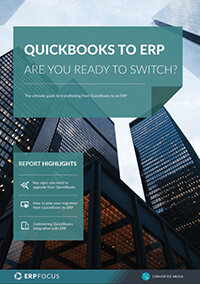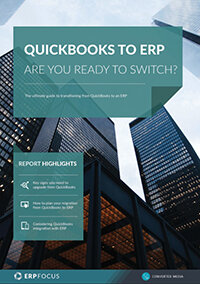Quickbooks: integrate or abandon once you’ve selected ERP?
In 2015, we said, “If your enterprise is…small in scale and it appears that ERP-like requirements have come to the fore, QuickBooks does offer a long list of third-party integrations that offer ERP capabilities and an alternative to a complete migration of QuickBooks…”.
However, between then and now, cloud platforms have really picked up speed, both in terms or reduced cost, and overall operability for the typical SME. It's worth revisiting the topic with this is mind.
As one might expect, similar business constraints apply today, just as they did in 2015 including:
Transaction volume
In this event, defining and measuring the total number of daily transactions is a reasonable way to determine whether you should ‘integrate’ or move on to a pure ERP platform. If your bookkeeping easily deals with a minimum number of transactions on a daily basis, then QuickBooks may still be a ‘pro’ pick.
Guide: Quickbooks to ERP - are you ready to make the switch?
However, if your operations have become ponderous, when it particularly comes to granular revenue and expense reporting, then this behavior suggests a ‘con’ path leading to the ultimate research and selection of a pure ERP solution.
User count
If your enterprise manages less than five or more full-time employees (FTEs), QuickBooks will probably operate nominally, only requiring select ERP-like ‘integrations’ to keep the ‘pro’ side of the operational equation greased properly.
However, if you have grown beyond this five-employee threshold, as a basic management system QuickBooks can become somewhat problematic. In this event, and similar to the previous transaction volume measurement, difficulties associated with operational speed and reporting may suggest a hard look at the ‘con’ side of the legacy Quickbooks environment.
Expanded financial compliance
As companies grow, accounting tenets tend to demand more sophisticated capabilities. This is particularly true in specialized business segments like chemical manufacturing or pharmaceutical production.
In these events, companies tend to demand tier-1 GAAP capabilities in order to handle complex issues relating to compliance such as state and/or federal regulations, various industry standards, and corporate quality assurance initiatives.
On the other hand, ‘vanilla’ QuickBooks offers zero capability on either side of the operational compliance ledger. As an SME, then, these two elements alone put you firmly on the ‘con’ side of the Quickbooks integration vs. ERP pick list.
Internal throughput
While throughput issues tend to exhibit negative behaviors on the transaction side of SME operations first, as a rule, once Quickbooks begins to outrun its internal capabilities, utility-level concerns also begin to crop up. Anecdotally speaking many solution partners suggest that QuickBooks exhibits negative behavior once its core record density approaches 250 MB in size, although there is no empirical information to prove this.
Nevertheless, based on practical experience alone performance issues do begin appear once any internal list exceeds 10,000 records. Consequently, should an SME begins to experience slow internal response, this is usually a pretty good indicator that it’s time to throw the Quickbooks baby out the window and find a more sophisticated ERP solution.
As one might expect; all of these pro/con ‘takes’ are highly subjective, and highly dependant on the needs of a particular enterprise. However, whether you decide to focus on the 2015 suggestions, or the updated takes, there should be plenty of intellectual grist in the ‘go or stay’ mill to work with.
Free white paper

Quickbooks to ERP: Are You Ready to Switch?
Get the definitive guide to converting your business from Quickbooks to ERP

Featured white papers
Related articles
-

Nine signs you need an eCommerce ERP integration
A guest blog from Brightpearl discussing eCommerce ERP and integration
-

CMMC Compliance: What Aerospace and Defense Manufacturers Need to Know
Key insights on CMMC compliance, deadlines, and securing DoD contracts with CMMC 2.0 certificatio...
-

Top ERP systems for small businesses
Which ERP solutions are best for small business needs? Information on features, scalability and m...


